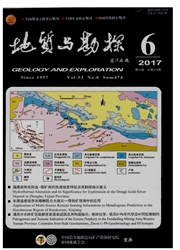

 中文摘要:
中文摘要:
东昆仑夏日哈木铜镍矿床以赋存110万吨Ni金属成为全球镍床近二十年来最重要的发现之一,也是仅次于金川岩浆铜镍矿床的中国第二大铜镍矿床。矿区发育5个镁铁-超镁铁质岩体,目前仅Ⅰ号镁铁-超镁铁岩体内发现了具有经济价值的超大矿体,110万吨Ni金属均赋存Ⅰ号岩体内;其他4个岩体中仅Ⅱ号岩体发现了矿化,是多种构造体制叠加岩浆活动的结果。调查发现Ⅱ号岩体的主要岩性是辉长岩,LA ICP-MS锆石U-Pb测试获得Ⅱ号岩体辉长岩的成岩年龄为385.2 Ma,比Ⅰ号岩体成岩成矿时代稍年轻,属于早泥盆世岩浆活动的产物。岩浆铜镍矿体多赋存于辉石岩与橄榄岩中,辉长岩内一般无经济价值的矿体存在。在夏日哈木矿区,辉长岩基本是含矿辉石岩及橄榄岩的围岩,辉长岩中所见的铜镍矿化也是后期岩浆活动贯入的表现。结合区域年代学综合分析认为,夏日哈木超大型岩浆铜镍硫化物矿床的形成,是早泥盆世早期岩浆活动于柴达木盆地边缘东昆仑造山带夏日哈木地区具体的成矿表现。目前所发现的Ⅱ号岩体以辉长岩为主,不具备成镍矿良好条件,较难发现有经济价值的铜镍矿体。
 英文摘要:
英文摘要:
The Xiarihamu Cu-Ni sulfide deposit,containing ~ 1. 1 million tons of Ni metal,represents the most significant discovery in the history of global Ni exploration in the past two decades and is the second largest Ni deposit following the Jinchuan deposit in China. There are five mafic-ultramafic intrusions in the mining area. At present,all large-scale ore bodies with economic values have been discovered in the No. I intrusion,with 1. 1million tons of Ni metal. Among the other four intrusions,the mineralization was found only in the No. Ⅱ intrusion,which resulted from superposition of magma activities of a variety of tectonic systems. In lithology,gabbro dominates the No. Ⅱ intrusion. LA-ICP-MS zircon U-Pb analysis of the gabbro yielded a diagenetic age of 385. 2 Ma. It is the product of the early Devonian magmatic activity,slightly younger than No. I intrusion. Howerver,the magmatic Cu-Ni ores mostly exist in the Ol-pyroxite and peridotite,and there are generally no economically valuable ore bodies in the gabbro. In the Xiarihamu mining area,gabbro is largely the surrounding rock of peridotite and pyroxenite which hold Cu-Ni ores. The Cu-Ni mineralization observed in the gabbro is just a manifestation of late magmatic activity. Combined with the regional geochronology,it is concluded that the formation of the Xairihamu super-large magmatic Cu-Ni sulfide deposit was associated with the early Devonian magmatic activity in the East Kunlun orogenic belt. The No. Ⅱ mafic-ultramafic intrusion is dominated by gabbro,without good formation conditions of Cu-Ni ores,so it seems impossible to find Cu-Ni ore bodies with economic values in the No. Ⅱ intrusion.
 同期刊论文项目
同期刊论文项目
 同项目期刊论文
同项目期刊论文
 期刊信息
期刊信息
